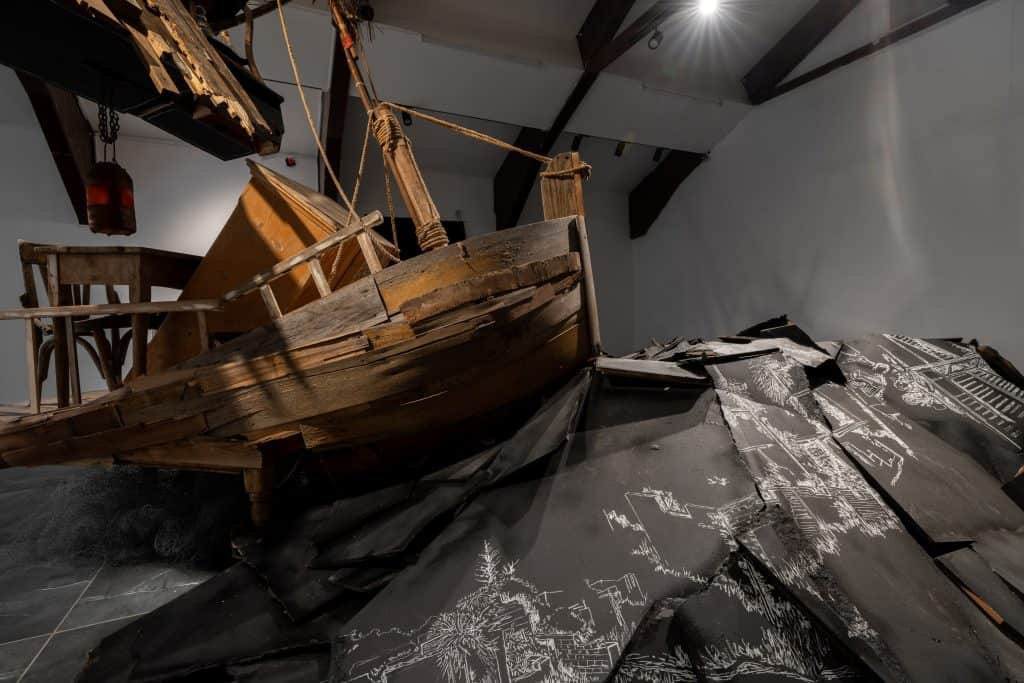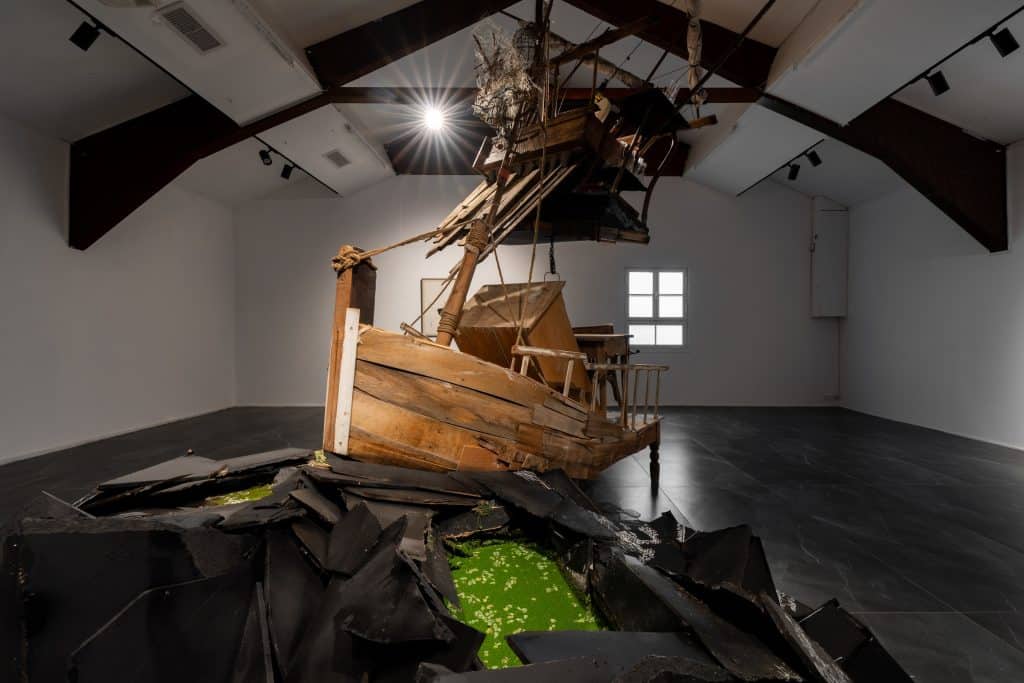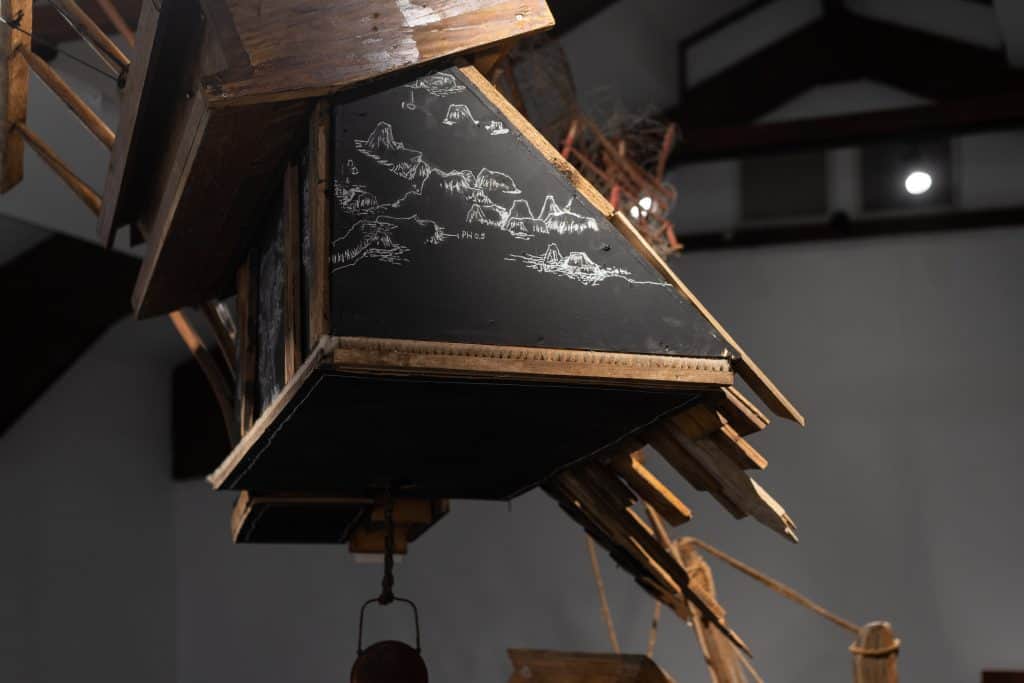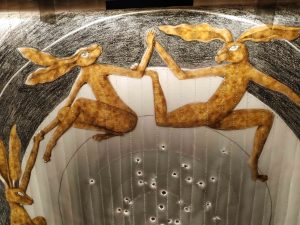The exhibition was realized thanks to Art Lane Fund’s generous support.
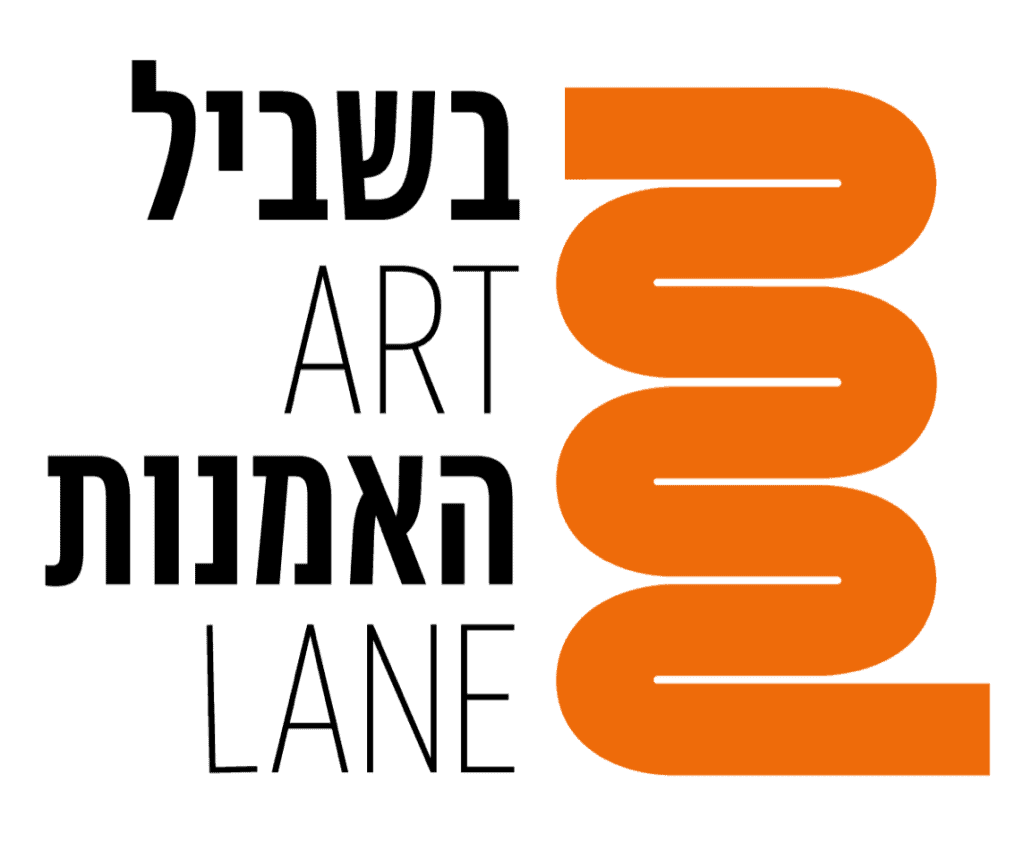
Earth Diver- The Journey Beyond the End of Time
The time: After the year 2150. Boats are sailing, moving beyond the horizon, hauling cultural relics and debris into a new era – the beginning of a new life. In the post-world, earth, nature, objects, culture, and human knowledge are swept away to new continents, imprisoned there, and a new world is born.
In ancient myths and folklore, the Earth-diver is an animal or bird. It dives into the water or into the chaos to bring up a handful of dirt, sometimes a grain or seed, from which the land will grow. The Earth-diver may be the creator taking the form of an animal or bird sent by the creator himself or the hero of the flood. Many myths tell of a series of failed attempts to find land, either by that animal but often by several different animals.
The question Nivi Alroy and Atar Geva deal with is what will be on earth.
This question has become one of the most discussed in global research. Weizmann Institute researchers marked 2020 as the year when, for the first time, the mass of human products – from skyscrapers to plastic bottles – surpassed nature’s weight on the globe. This is yet another conclusive evidence of the Anthropocene age: the period that marks human and human-ways influence on the environment. We are at a breaking point, and humans are adding more buildings, roads, and transportation at a rate that doubles every twenty years, leading to a “concrete jungle” expected to double its ecological biomass against nature and its resources in the next twenty years.
Nivi Alroy and Atar Geva are developing a multi-sensory artistic exhibition sequence in their ongoing project. It’s an imaginary journey toward a reboot.
The starting point is the moment when time unravels and is reborn. This collaboration between two leading Israeli artists working in various media is exciting and not trivial. Working together allows for a richer and more complex creation.
The project weaves an imaginary journey world that deals with the connection between memory and trauma and allows scarred sites to heal through evolution and movement. The artistic journey consists of a series of exhibitions taking place in Israel and around the world. They include sculpture, video, installation, painting, and sound, and they relate to the spaces and cultural history of the sites in which the project is presented in collaboration with researchers and writers from various research fields.
In the previous segments, a video was filmed, and a site-specific installation was placed in an old water tower in the Jezreel Valley. Another large installation, commissioned by the Israeli Consulate in Rome, was later placed in the Nuvola Convention Center as part of the Arte in Nuvola Art Fair (November 2022). The journey continues in winter 2023 in the sulfur mines and the old sulfur factory near Kibbutz Beeri, across from Gaza, and in Beeri Gallery. It will go on in the spring at The Israel Museum in Jerusalem, and each station will screen a video from the previous one.
The installation takes a new form, adapting to the hosting locations’ architectural conditions and historical and cultural baggage. It offers a new view of ecology, memory, and culture uniquely and experientially and is designed for diverse audiences. The artists place great importance on combining lectures and meetings with the audience, researchers, and creators at the sites where the installation operates.
At the station located in the Beeri Gallery, two of the boats reach a dead end. One boat is hung from the high ceiling, seemingly hovering in the air, its sails entangled in debris collected from Israel’s beaches. A lit lantern spinning on its axis hangs from its’ haul, signaling and pulsing like a lighthouse. A sign of life? A warning light? The ship carries research tools, a microscope, and test tubes left behind by a nameless traveling scientist. Cultural relics. The second ship ran aground on black wooden slabs, which lay in piles, resembling tectonic plates or a volcano crater. Beneath, there are frothing pools of seaweed and aquatic plants. On the boards, the area’s landscapes are painted in white chalk: The sulfur mines, the sulfur factory, the ammunition complex, the fields, and the dirt roads.
The sulfur mines near Beeri are a fascinating site that stirs the imagination. The sulfur reserves were discovered by a British officer named Williams on the eve of Gaza’s occupation in 1917. In 1930, he established a sulfur mining company, and in 1933, assisted by experts from England and laborers from Gaza, he began producing sulfur. Mining was halted during World War II due to a shortage of spare parts and an inability to market the sulfur, and the factory was abandoned. By the time the War of Independence had started, the factory was largely destroyed, and everything dismantleable was taken by the residents of the area – Arabs, Bedouins, and Israeli settlers – who used them to build bunkers and emplacements. The factory’s skeleton still stands tall and is very distinct in the landscape; through its missing windows, blue skies are visible, and the heavy iron conveyor stands still. The mining pits are filled with seasonal flowers every winter, but they’re absorbed by the pungent smell of sulfur.
How did Nivi Alroy and Atar Geva’s ships reach the coast of Gaza and the sulfur complex?
How did Nivi Alroy and Atar Geva’s ships reach the coast of Gaza and the sulfur complex? Did mankind use sulfur in ancient times, in distant days beyond time, in extinct civilizations? And who navigates the boats? What do they carry with them?
Perhaps they bring a utopian gospel, a hope of rebooting, of healing the scars of the past and present in a region so fraught with tensions and saturated with war, like the Gaza Strip.


